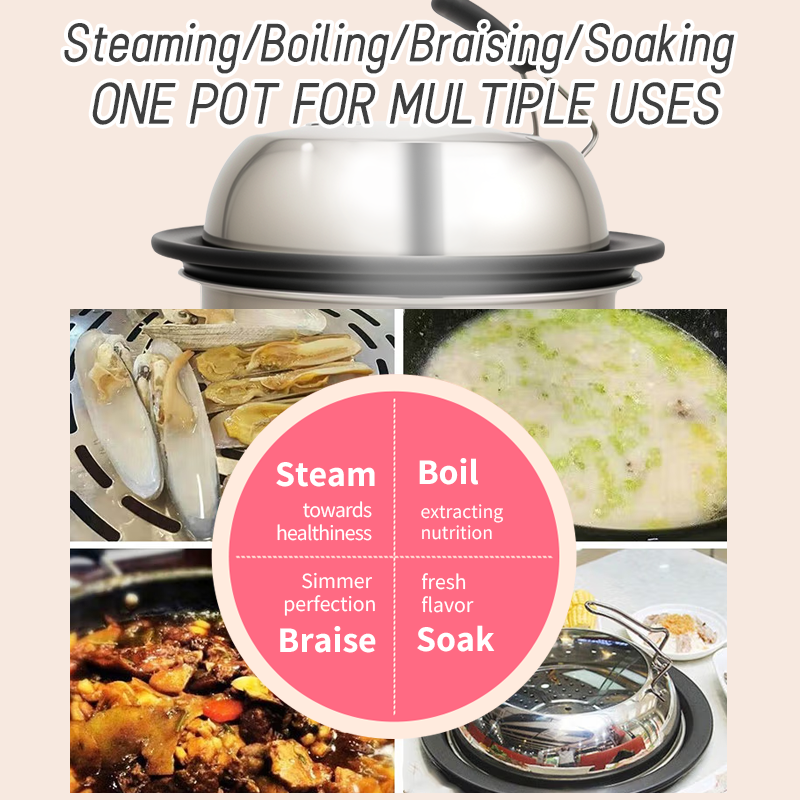I. The Origin of Steam Hot Pot and Southeast Asian Culinary Culture
The origins of steam hot pot can be traced back to the traditional steaming culture of southern China. It later spread to Southeast Asia with Chinese immigrants, integrating with local culinary traditions. In the humid and hot climate of Southeast Asia, steam pots quickly gained popularity due to their oil-free cooking and ability to preserve the original flavor.
For example, Vietnam's "Lẩu Hơi" uses bamboo steamers and is seasoned with fish sauce and lemongrass. Thai steam hot pot often incorporates coconut milk and lime leaves for a spicy and sour flavor. This cooking method not only aligns with Southeast Asians' pursuit of a "natural and healthy" diet, but has also become a popular venue for family gatherings and festive occasions.
II. Southeast Asian Steam Hot Pot Market Analysis
1. Steam Hot Pot Market Size and Regional Characteristics
According to the "2023 Southeast Asian Food and Beverage Report," the steam hot pot category is expected to grow annually by 12%, with Vietnam and Thailand leading the way. In Singapore, due to strong demand for high-end dining, restaurants specializing in seafood steam pots have average customer spending exceeding US$50. Indonesia, on the other hand, favors affordable chain stores, with average daily customer traffic reaching 200 per restaurant.
2. Insights into Consumer Demand for Steam Hot Pots
Health-Oriented: 75% of consumers choose steam hot pot for its "low fat and additive-free" nature (data source: FoodTrends SEA).
Social Context: The shared dining experience aligns with Southeast Asia's emphasis on family gatherings, leading to a 40% increase in holiday orders.
Localized Innovation: For example, Malaysia has launched a "herbal steam pot" that incorporates angelica and wolfberry into its broth, appealing to those who prioritize health.
III. Market Trends and Business Opportunities for Steam Hot Pots
1. Technological Upgrades Drive Experience Innovation. Smart steam pot devices (such as app-based temperature control and automatic water addition) lower operational barriers, leading to an 18% annual increase in steam pot sales in the home market. The brand "SteamEats" launched a rental service in the Philippines, catering to family gatherings.
2. Sustainable Operations in Steam Hot Pots Become a Focus
• Using Eco-Friendly Materials in Steam Pots: The Vietnamese restaurant "Green Steam" uses biodegradable bamboo steaming trays, reducing plastic consumption by 30%. • Optimizing the local steam pot supply chain: Thai manufacturers collaborate with fishermen to directly supply live shrimp, achieving transparent traceability "from ocean to steam pot."
3. New cross-industry integration scenarios
Cultural and tourism integration: Bangkok's "Riverside Steam Hot Pot Cruise" combines dining with sightseeing, increasing average customer spending by 60%.
Pop-up store marketing: A Singaporean brand partnered with a tea shop to launch a "steam pot + herbal tea" combo, garnering over 500,000 impressions on social media.
IV. Steam Hot Pot Success Story: The Operational Strategy of "Ocean Steam" in Kuala Lumpur
Positioning: A high-end seafood steam hot pot restaurant
Steam Pot Features:
Using a layered steam pot, the bottom layer simmers the Malay laksa broth, while the upper layer steams lobster and abalone;
Introducing a "DIY seasoning station" offering 20 Southeast Asian specialties;
Collaborating with local influencers to livestream the cooking process, the Douyin topic has garnered over 10 million views.
Achievements: Return on investment within one year of opening, expansion to three branches, and a 35% member repurchase rate.
5. Frequently Asked Questions (FAQs) about Steam Hot Pot
Q1: What are the advantages of steam hot pot over traditional hot pot?
A: Steam hot pots are safer because they don't have an open flame. The steam circulation locks in nutrients, making them suitable for children and those who are exercising.
Q2: What precautions should be taken when using a steam hot pot at home?
A: Steam pots should be made of food-grade 304 stainless steel and descaled regularly to extend their lifespan.
Q3: Which cities in Southeast Asia are popular for steam hot pot?
A: Bangkok, Ho Chi Minh City, and Singapore are popular destinations for steam hot pot, as they are home to numerous specialty steam hot pot restaurants in their business districts and night markets.
Q4: How can the cost of opening a steam hot pot restaurant be reduced?
A: Adopt a "miniaturized equipment + takeout package" model to reduce space requirements. Refer to the example of the 30-square-meter "Steam Box" restaurant in Bangkok.
VI. Steam Hot Pot Market Growth Rate Analysis
1. Overall Steam Hot Pot Market Growth Rate
The Southeast Asian steam hot pot market size in 2023 is expected to be approximately US$820 million (Source: Statista), with an annual growth rate of 12-15%, significantly higher than traditional hot pot (6%) and barbecue (8%) categories.
Steam hot pot growth drivers:
Demand for a healthy diet: Post-pandemic, consumers have increased their preference for low-fat and low-salt cooking methods;
Resurgence in social activities: Demand for family gatherings and get-togethers with friends has surged, making steam hot pot a highly suitable option for sharing;
Technological innovation in steam hot pot: The widespread adoption of smart steam pots has lowered the barrier to home use.


